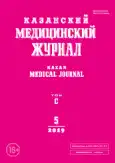Влияние сахарного диабета на липидный спектр крови у пациентов с рестенозом венечных сосудов, ассоциированным с Helicobacter pylori
- Авторы: Гаджиева С.З.1
-
Учреждения:
- Азербайджанский медицинский университет
- Выпуск: Том 100, № 5 (2019)
- Страницы: 774-778
- Тип: Теоретическая и клиническая медицина
- URL: https://journals.rcsi.science/kazanmedj/article/view/16361
- DOI: https://doi.org/10.17816/KMJ2019-774
- ID: 16361
Цитировать
Полный текст
Аннотация
Цель. Определить влияние сахарного диабета на уровень липидного спектра крови у пациентов с рестенозом венечных сосудов, ассоциированным с Н. pylori.
Методы. В исследование включены 50 пациентов с ишемической болезнью сердца и рестенозом венечных сосудов, ассоциированным с инфицированием H. pylori. Больные были разделены на две группы: с сопутствующим сахарным диабетом (первая группа, n=10) и без него (вторая группа, n=40). Группы были сопоставимы по возрасту, полу и клинико-ангиографическим данным. Все больные на фоне базисной терапии дополнительно получали стандартную антихеликобактерную терапию первой линии в соответствии с Маастрихтским консенсусом-3 (2005) в течение 14 дней. До лечения и через 90 дней после лечения оценивали показатели липидного спектра крови на аппарате Siemens Dimension X pand plus. Для анализа полученных цифровых данных вычислены средняя арифметическая величина (М) и ошибка средней (m). Статистическая значимость разницы между показателями групп определялась χ2-критерием Пирсона. Различия считали достоверными при р <0,05. Статистическую обработку данных осуществляли с помощью статистического пакета SPSS и электронной таблицы Excel 2013.
Результаты. Сравнительный анализ качественных показателей продемонстрировал, что в обеих группах в большинстве случаев (соответственно 90 и 87,5%) уровень липопротеинов низкой плотности был выше нормы, однако между группами они не различались (χ2=0,047; р=0,828). После эрадикации в обеих группах достоверно улучшились как качественные (соответственно 60 и 67,5%), так и количественные показатели липопротеинов низкой плотности (соответственно уменьшились до 98,2±8,6 и 97,6±7,9 мг/дл), при этом достоверных различий между группами не было (p ˃0,05).
Вывод. Наличие в анамнезе сахарного диабета у пациентов с рестенозом венечных сосудов, ассоциированным с Н. pylori, нельзя рассматривать в качестве дополнительного фактора, повышающего вероятность развития нарушения липидного спектра крови; проведение успешной эрадикационной терапии у данной категории пациентов способствует нормализации липидного спектра крови вне зависимости от наличия или отсутствия сопутствующего сахарного диабета.
Ключевые слова
Полный текст
Открыть статью на сайте журналаОб авторах
Самира Закир гызы Гаджиева
Азербайджанский медицинский университет
Автор, ответственный за переписку.
Email: mic_amu@mail.ru
Азербайджан, г. Баку, Азербайджан
Список литературы
- Арутюнов Г.П. Сахарный диабет и атеросклероз. Какова оптимальная стратегия сдерживания атеросклеротического процесса? Сердце. 2004; (1): 36–40.
- Волков В.И., Серик С.А. Сахарный диабет и коронарный атеросклероз. Атеросклероз. Науч.-практ. ж. 2011; 7 (2): 5–22.
- Stevens R.J., Kothari V., Adler A.I., Stratton I.M. The UKPDS risk engine: a model for the risk of coronary heart disease in type II diabetes (UKPDS 56). Clin. Sci. (Lond.). 2001; 101: 671–679. doi: 10.1042/cs1010671.
- Ho J.E., Paultre F., Mosca L. Is diabetes mellitus a cardiovascular disease risk equivalent for fatal stroke in women? Data from the Women’s Pooling Project. Stroke. 2003; 34: 2812–2816. doi: 10.1161/01.STR.0000102901.41780.5C.
- Syvanne M., Taskinen M.-R. Lipids and lipoproteins as coronary risk factors in non-insulin-dependent diabetes mellitus. Lancet. 1997; 350 (Suppl. I): 20–23. doi: 10.1016/S0140-6736(97)90024-6.
- Lehto S., Ronnemaa T., Haffner S.M. et al. Dyslipidemia and hyperglycemia predict coronary heart disease events in middle-aged patients with NIDDM. Diabetes. 1997; 46: 1354–1359. doi: 10.2337/diab.46.8.1354.
- Vijayvergiya R. Association of infection with coronary artery disease. Indian J. Med. Res. 2007; 125: 112–114. PMID: 17431279.
- Ayada K., Yokota K., Kobayashi K. et al. Chronic infections and atherosclerosis. Clin. Rev. Allergy Immunol. 2009. 37: 44–48. doi: 10.1007/s12016-008-8097-7.
- Павлов О.Н. Роль инфекции в патогенезе атерогенного воспалительного процесса. Клиницист. 2013; (1): 9–13. doi: 10.17650/1818-8338-2013-1-9-13.
- Tan H.J., Goh K.L. Extragastrointestinal manifestations of Helicobacter pylori infection: facts or myth? A critical review. J. Dig. Dis. 2012; 13 (7): 342–349. doi: 10.1111/j.1751-2980.2012.00599.x.
- Stone A.F., Risley P., Markus H.S. et al. Ischaemic heart disease and Cag A strains of Helicobacter pylori in the Caerphilly heart disease study. Heart. 2001; 86: 506–509. doi: 10.1136/heart.86.5.506.
- Vizzardi E., Bonadei I., Piovanelli B. et al. Helicobacter pylori and ischemic heart disease. Panminerva. Med. 2011; 53 (3): 193–202. PMID: 21775946.
- Vafaeimanesh J., Hejazi S.F., Damanpak V. et al. Association of Helicobacter pylori infection with coronary artery disease: is Helicobacter pylori a risk factor? Sci. World J. 2014; 2014: 516354. doi: 10.1155/2014/516354.
- Pasceri V., Cammarota G., Patti G. et al. Association of virulent Helicobacter pylori strains with ischemic heart disease. Circulation 1998; 97: 1675–1679. doi: 10.1161/01.CIR.97.17.1675.
- Rogha M., Nikvarz M., Pourmoghaddas Z. et al. Is Helicobacter pylori infection a risk factor for coronary heart disease? ARYA Atheroscler. 2012; 8: 5–8. PMID: 23056092.
- Sharma V., Aggarwal A. Helicobacter pylori: Does it add to risk of coronary artery disease. World J. Cardiol. 2015; 7 (1): 19–25. doi: 10.4330/wjc.v7.i1.19.
- Niemelä S., Karttunen T., Korhonen T. et al. Could Helicobacter pylori infection increase the risk of coronary heart disease by modifying serum lipid concentrations? Heart. 1996; 75: 573–575. doi: 10.1136/hrt.75.6.573.
- Saton H., Saijo Y., Yoshioka E., Tsutsui H. Helicobacter pylori infection is asignificant risk for modified lipid profile in Japanese male subjects. J. Atheroscler. Thromb. 2010; 17: 1041–1048. doi: 10.5551/jat.5157.
- Kucukazman M., Yavuz B., Sacikara M. et al. The relationship between updated Sydney System score and LDL cholesterol levels in patients infected with Helicobacter pylori. Dig. Dis. Sci. 2009; 54: 604–607. doi: 10.1007/s10620-008-0391-y.
- Pellicano R., Oliaro E., Fagoonee S. et al. Clinical and biochemical parameters related to cardiovascular disease after Helicobacter pylori eradication. Int. Angiol. 2009; 28: 469–473. PMID: 20087284.
Дополнительные файлы






